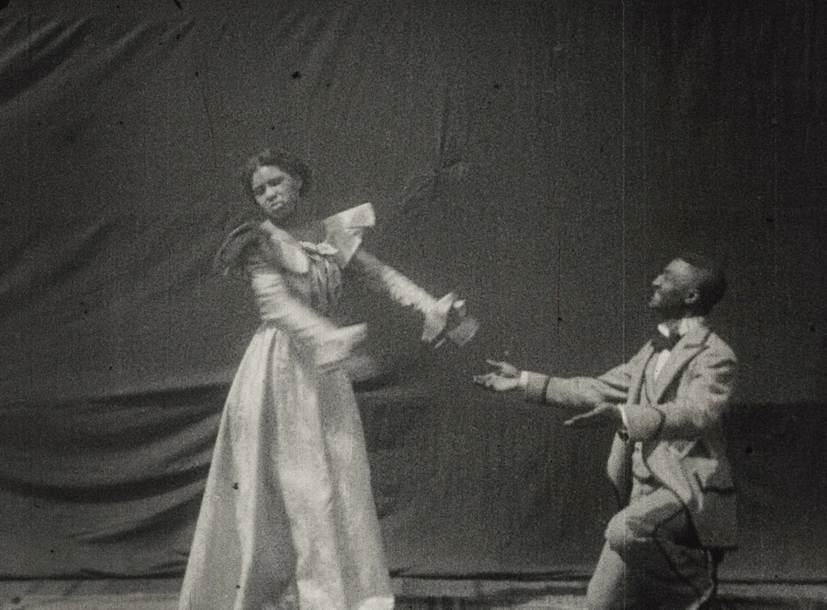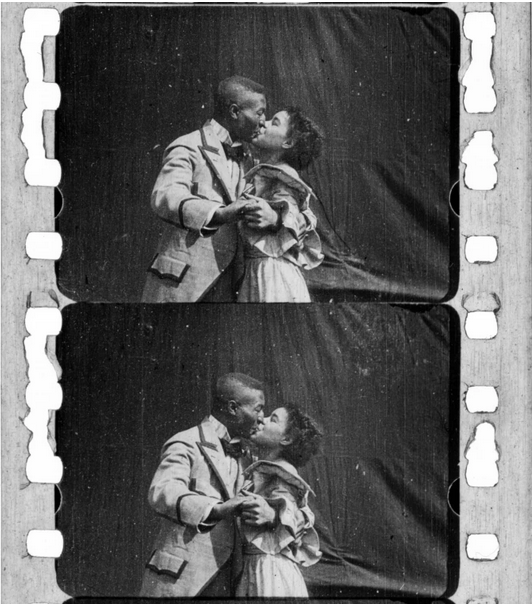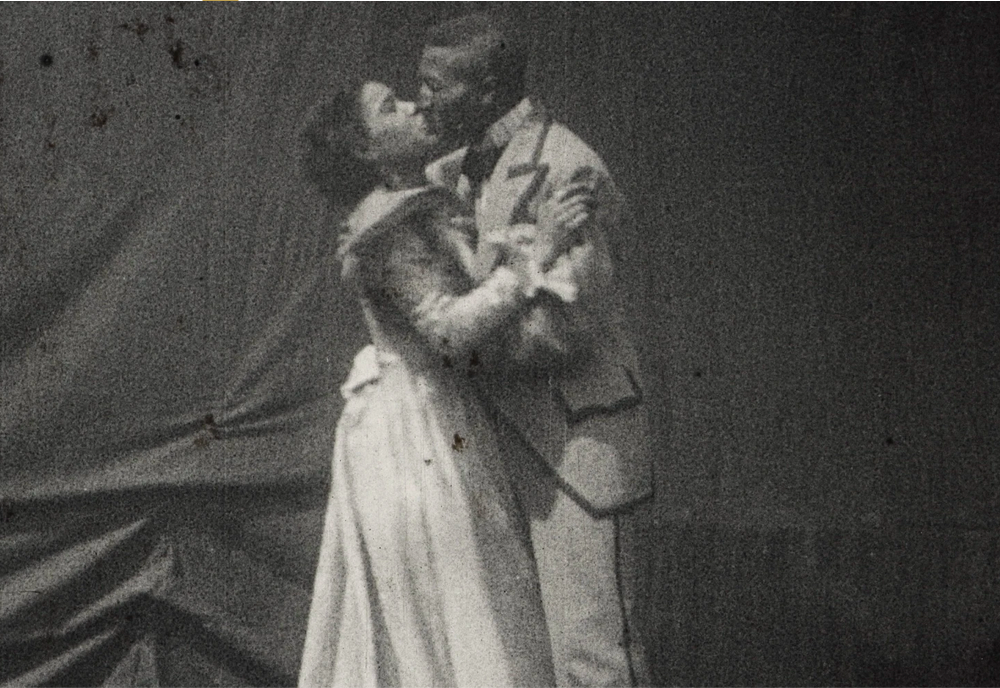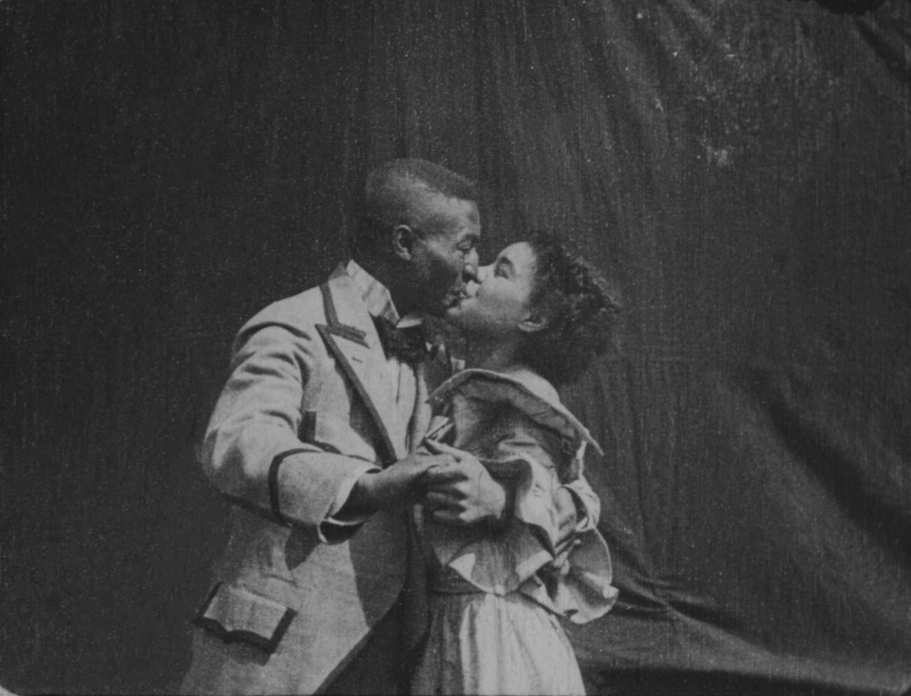Rummaging through a box of unidentified film reels in 2017, University of Southern California archivist Dino Everett did not expect to unroll a film that showed a black couple dressed in costumes typical of minstrel shows, in a romantic hug. Everett had rediscovered a lost moment in the history of cinema: the short film Something good, a nigga kiss by William N. Selig (1898), the earliest known depiction of a moment of intimacy between two black people on screen, with actors Gertie Brown and Saint Suttle.
Rethinking the history of cinema
In 1898, Gertie Brown and Saint Suttle were best known as vaudeville performers and their appearance in this silent short film quickly became a symbol of what blacks could do on screen, breaking with the racist caricatures and stereotypes that prevailed in American cinema. era. In the 19th century, racist minstrel shows, with whites dressed as blacks, were the order of the day. Something good reversed that narrative – and is now prompting scholars and curators to rethink early cinema.
It’s 29 seconds of true affection – kissing, hugging, evaluating, kissing again – shot at a time when cinema was teeming with racist caricatures and stereotypes.
Dino Everett contacted Allyson Nadia Field, an associate professor in the Department of Film and Media Studies at the University of Chicago. Together they identify and date the film, “using a combination of physical evidence of the film itself, punch holes, press holes, as well as his experience as an archivist and my work as a historian,” Allyson said. “So it took a while.”
The film went viral. The video made history more than a century after it was shot. Allyson observes: “On the one hand, people, especially many African Americans, saw an image they thought did not exist. It’s like filling a void in a visual culture. While much of what we know from the silent film portrays African Americans in incredibly dehumanizing ways, this film, I think, serves as a counter image. “
A comment on Twitter specifically expressed the following idea: “The nation could have always had this kiss, but instead is cursed because of the racist film. Birth of a nation«.
Allyson’s work focuses on the intersections between the archive and the history of African American cinema. After becoming an Academy Film Scholar in 2019, she is working on a book that rethinks “the emergence of American cinema. The book is a deep dive Something good. “It’s about reconsidering these familiar objects, but also about taking into account the newly rediscovered films,” adds Allyson.
An alternate version of Something good, a nigga kiss discovered in Norway
Finding a reel of a black couple flaunting their intimacy on screen in 1900 was already a surprise. But this surprise was increased tenfold shortly after the film was identified, when another version was discovered in Leksvik, Norway. This reel, twice as long as the first one, is a mirror image. Researchers from the National Library of Norway have since concluded that this Something good he arrived in the Scandinavian country in 1898 via a man named Hans Killingberg, who was returning from a trip to the United States. As Guzmán explains, “it’s really fascinating to see these films circulating all over the world at that time”.
The film was stored in a barn in Norway
In the early 1990s, the library received a reel from Leksvik, a small municipality in central Norway. It had been stored in a barn until firefighters deemed it posed too great a fire hazard. It was sent to Oslo, where researchers were unable to identify it, but recorded it as a Lumière film due to its perforations.
“There are usually four holes on each side of an image, but in Lumière films, there are two, one on each side,” says Bent Bang-Hansen, researcher librarian at the Norwegian National Library. “This reel has these strange perforations that were invented by the Lumière brothers in France. I had no idea they were used in the United States. We thought the content was American, but those holes took us to France and Europe. So this has always been a puzzle to us. “
Shortly after the identification of Something good at USC, Bent Bang-Hansen’s colleague Tone Føreland recognized the actors. It turned out that Leksvik’s reel contained a similar version of this Selig film, as well as another film titled The tramp and the dog, Selig’s first film, which was initially thought to be lost. “It’s truly a coincidence that so many pieces have come together,” says Randy Haberkamp, senior vice president of conservation and foundation programs at the Academy.
The riddle of the Norwegian version

So what is the nature of this version of Something good? And how did it end up in Leksvik in the first place? According to Eirik Frisvold Hanssen, head of films in the library’s research department, Norwegian Hans Killingberg returned from a trip to the United States in 1898, with the films and parts needed to make a projector.
“He apparently painted one of the walls of his barn white and used it as a screen to show movies with his projector,” says Eirik. This happened shortly after the first film was shown in the country’s capital and has been a part of Leksvik folklore ever since. The Eirik team has come to believe that this version was produced for the international market, which is why it may not have been marked as a separate entry in the Selig catalog.
“There are a lot of things that are weird, and that’s why this stuff is exciting, because it’s like a mystery. It’s detective work, ”says Allyson. Eirik’s team first contacted her to help her piece the puzzle together in 2019.
Note that Selig films were usually made in alternate versions, 25-foot and 50-foot reels that appeared in the Sears catalog in those different lengths. But the Norwegian version is even longer than the 50-foot version identified in 2018.
His research is all the more complicated since there were many cases of hacking at the time. Distributors, exhibitors and even film producers were selling films with different titles. “The Norwegian copy might just be Something good – Negro Kiss refurbished, “Allyson said.” I’m trying to unravel all these connections and understand what these artifacts are. The film about Norway then adds a new stone to the building. There are more. “
The most interesting thing for Allyson about the Norwegian version is that it goes beyond the image of a kiss without paint and without caricature. Show professional artists at work.
The two actors Saint Suttle and Gertie Brown

Saint Suttle and Gertie Brown were vaudeville artists, part of a group called the Ragtime Four. As Eirik explains, “What I find interesting about the California version that aired a few years ago is that it’s very simple. She is very pure. She really focuses on the kiss. This Norwegian version has a longer prelude, where he makes advances and she rejects them, then they kiss at the end. The kiss itself is much more than a performance. “
“Their playing style is more comical,” he adds. The two versions could also be considered different genres, the American version being a variant of The kiss of Edison (the most popular film of 1896) and the Norwegian version is more of a vaudeville act.
The impossible restoration of the film

Norwegian Cinematheque scanned the film a second time to preserve it before its condition deteriorates. But, Bent Bang-Hansen observes, no restoration can make it perfect. “We have to consider that it has never been spotless,” he says. “They developed the material in buckets. There was no water filtration, so many of those little specks may have been there from the start. “
For now, the copy is kept in a building near the Arctic Circle, a hundred kilometers from Oslo. It only comes out for short periods of time to examine and scan it, and yet the roller begins to deteriorate and the nitrate becomes sticky.
The tramp and the dog (1896)
The tramp and the dog (1896) is considered the first commercial production of the American director William Selig at the Selig Polyscope. It is also probably the first commercial narrative film shot in Chicago. Described as a backyard comedy (“Backyard Comedy,” shot in the Rogers Park neighborhood), in the first clip, a baker walks out into her backyard and lets a cake cool on a chair. A wanderer jumps over the yard fence, grabs the cake and tries to jump over the fence again. A bulldog appears and grabs the bum’s butt trying to escape, causing several falls and the reappearance of the woman with a broom.
The film became very popular and was released in North America and Europe. He started a film trend known as Humor pants (pants humor), where the loss or threat of loss of the character’s pants is the main gag. I have encouraged many directors to portray tramps and tramps in short comic situations.
Sources
Andrew A. Erish, William N. Selig, the man who invented Hollywood, University of Texas Press, 2012.
Michael Smith and Adam Selzer, Flickering Empire: How Chicago Invented the US Film Industry. Columbia University Press, 2015, p. 42–43.
A piece of American cinema history in Norway, A frame, February 25, 2021.
Sidonie Talla Mafotsing Line, How 20 seconds of film changed the history of cinema, Atlas Obscura, October 21, 2022.
Paola Kiley, How a 20-second film of black artists kissing was rediscovered in 1898. And why it matters, Kcet, September 22, 2022.


